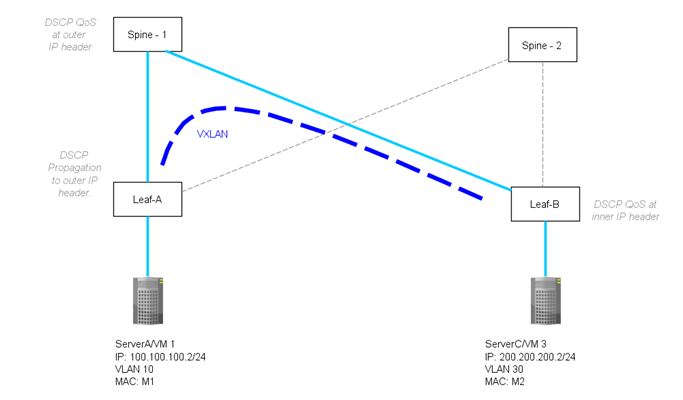QoS for VXLAN Layer 3 Gateways
SLX-OS VXLAN Layer 3 gateways can support QoS.
A VXLAN Layer 3 gateway allows inter-subnet communication through the VXLAN configuration. In the following figure, the leaf nodes act as the VXLAN Layer 3 gateway. Spine-1 and Spine-2 act as IP routing nodes that route the VXLAN packet out between Leaf-A and Leaf-B. Hosts on different subnets cannot learn MAC addresses of each other in a VXLAN network.
The leaf nodes resolve ARP for a tenant VM. The leaf nodes advertise the host routes to each other and tenant VMs with the next hop configured as VTEP. In the following figure, VM1 on a VXLAN network is sending a packet to VM3 on a VXLAN network. At Leaf-A, the DSCP of the tenant packet is propagated to the outer IP header. Leaf-A also adds a Layer 2 header corresponding to the VTEP gateway MAC, after the VXLAN header.
Optionally, the 802.1p VLAN and PCP marking of this inner Ethernet header can be set to a value corresponding to the received Layer 2 traffic class of the tenant packet. The Leaf-B terminating IP and Layer 2 headers ignore the QoS marking of transport network and proceed with marking the inner IP header.

Configuration example
A prerequisite for configuring QoS is to configure the TCAM profile that supports Layer 3 gateway. For more information, see Configure the TCAM Profile for Layer 3 Gateway.
The qos-ttl-mode uniform command sets the QoS type mode to uniform, which is the default. The following example configures uniform QoS support on a VXLAN gateway.
device(config)# overlay-gateway gateway_L3 device(config-overlay-gw-gateway_L3)# type layer2-extension device(config-overlay-gw-gateway_L3)# ip interface loopback 1 device(config-overlay-gw-gateway_L3)# qos-ttl-mode uniform device(config-overlay-gw-gateway_L3)# map vni auto device(config-overlay-gw-gateway_L3)# activate

